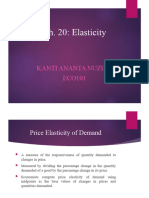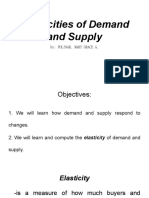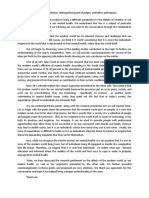All About Macc 121
All About Macc 121
Uploaded by
Joshua CaraldeCopyright:
Available Formats
All About Macc 121
All About Macc 121
Uploaded by
Joshua CaraldeOriginal Title
Copyright
Available Formats
Share this document
Did you find this document useful?
Is this content inappropriate?
Copyright:
Available Formats
All About Macc 121
All About Macc 121
Uploaded by
Joshua CaraldeCopyright:
Available Formats
MACC 121: MANEGERIAL ECONOMICS
ALL ABOUT DEMAND
Demand indicates how much of a product consumers are both willing and able to buy at each
possible price during a given period, ceteris paribus (all other things constant).
Individual Demand refers to the demand for a good or service by an individual.
Market Demand is the summation of the total individuals’ demand curve.
Demand Function is a mathematical representation of the relation between the quantity
demanded of a product and all factors that influence this demand.
Demand Schedule is a table that shows the quantity demanded of a good/service at different
price levels. It can be graphed as continuous demand curve on a chart where y-axis
represents price, and x-axis represents quantity.
Three (3) independent variables are price of the product, price of related products, and
incomes of potential customers.
The Law of Demand says that quantity demanded varies inversely with price, ceteris paribus.
Thus, the higher the price, the smaller the quantity demanded.
Substitution Effect is the decrease in sales for a product that can be attributed to consumers
switching to cheaper alternatives when its price rises. The change in the relative price (the
price of one good relative to the prices of other goods) causes the substitution effect.
Income Effect is the change in the demand for a good or service due to a change in the
consumer’s purchasing power.
Real Income is the earnings of individuals or the nation after adjusting to the extent of
inflation. It measures in terms of how many goods and services an individual can buy. It has
purchasing power dependent on the economy’s health. It is inversely proportional to inflation.
Money Income is the number of dollars or peso you receive per period.
Marginal Utility is the added satisfaction that a consumer gets from having one more unit of
good or services.
Law of Diminishing Marginal Utility states that satisfaction decreases as consumption
increases.
Elasticity of Demand refers to the degree to which demand responds to a change in an
economic factor.
If the price elasticity is ZERO, quantity demanded is UNAFFECTED by price, and demand
curve is VERTICAL.
If the price elasticity is INFINITE, a small increase in price will lead customers to PURCHASE
NONE OF THE PRODUCT, the demand curve is HORIZONTAL.
Demand is ELASTIC if the price elasticity is GREATER THAN 1 (>1).
UNITARY or UNIT-ELASTIC if EQUAL TO 1 (=1)
INELASTIC if LESS THAN 1 (<1)
Percentage change in price will result in larger percentage in the quantity demanded.
Demand is more elastic at higher prices and less elastic with lower prices.
For elastic demand, take note that price and revenue are inversely proportional; goods
are luxuries and has many substitutes.
“Be strong and courageous. Do not be afraid nor discouraged for the Lord your God is with you
wherever you go.”
---Joshua 1:9---
Charlene Mae B. Avanzado, Future CPA<3
For inelastic demand, remember that price and revenue are directly proportional,
because quantity demanded is less responsive to the change in price; goods are necessities
and has few substitutes.
Determinants of Demand Elasticity are the following:
1. Availability of Substitutes means that the greater the availability of substitutes for a good,
the greater the goods’ elasticity of demand.
2. Share of Consumers’ Budget Spent on the Good indicates that an increase in prices
reduced the demand.
3. A Matter of Time states that the longer the adjustment period, the greater the consumers’
ability to substitute.
4. Some Elasticity Estimates means that the elasticity of demand is greater in the long run
because consumer have more time to adjust.
5. Changes in Consumer Income means that if income increases, demand increases
(demand curve shifts to the right)
a. Normal Goods (income elasticity is positive) are consumer products such as food
and clothing that exhibit a direct relationship between demand and income. As a
consumer's income rises, the demand for normal goods also increases.
b. Inferior Goods (income elasticity is negative) are goods whose demand drops when
people's incomes rise.
6. Changes in the Price of Related Goods
a. Substitutes (coefficient is >0) are goods that compete with each other. When there
is a decrease in price of one item, the demand for a substitute good will decrease.
b. Complements (coefficient is <0) are goods used and consumed together. When the
price of one decreases, the demand of the other will shift to the right (means that
demand will increase).
7. Changes in Size or Composition of the Population and demand are directly
proportional.
8. Changes in Consumer Expectations and demand have an indeterminate relationship
(means that demand curve may shift either to the left (decreases) /right (increases))
9. Changes in Consumer Tastes is also indeterminate to the demand.
Income Elasticity of Demand measures the change in quantity demanded of a product given
a change in income.
Cross-Elasticity of Demand measures the change in demand for a good when the price of a
related or competing product is changed.
Marginal Propensity to Consume is the proportion of an increase in income that gets spent
on consumption. MPC varies by income level. MPC is typically lower at higher incomes.
Marginal Propensity to Save is the proportion of an increase in income that gets saved
instead of spent on consumption. MPS varies by income level and is typically higher at higher
incomes.
“Be strong and courageous. Do not be afraid nor discouraged for the Lord your God is with you
wherever you go.”
---Joshua 1:9---
Charlene Mae B. Avanzado, Future CPA<3
Formulas are the following:
a. Elasticity of Demand
% Change∈Quantity Demanded
% Change∈ Price
b. Income Elasticity of Demand
% Change∈Quantity Demanded
% Change∈ Income
c. Cross-Elasticity of Demand
% Change∈Quantity Demanded of Product X
% Change∈Price of Product Y
d. ARC Method
Change∈Quantity Demanded Change∈Price
÷
Average Quantity Average Price
e. Marginal Propensity to Consume
Change∈Consumption
Change∈ Income
f. Marginal Propensity to Save
Change∈Savings
Change∈Income
g. MPC + MPS = 1
“Be strong and courageous. Do not be afraid nor discouraged for the Lord your God is with you
wherever you go.”
---Joshua 1:9---
Charlene Mae B. Avanzado, Future CPA<3
You might also like
- Economics for CFA 2024: level 1 in just one week: CFA level 1, #4From EverandEconomics for CFA 2024: level 1 in just one week: CFA level 1, #4Rating: 4.5 out of 5 stars4.5/5 (2)
- Microeconomics: QuickStudy Laminated Reference GuideFrom EverandMicroeconomics: QuickStudy Laminated Reference GuideRating: 5 out of 5 stars5/5 (1)
- IMPORTANT TOPICS OF ECONOMICS BY Vikas Tomar Sir PDFDocument112 pagesIMPORTANT TOPICS OF ECONOMICS BY Vikas Tomar Sir PDFPrayagNo ratings yet
- A level Economics Revision: Cheeky Revision ShortcutsFrom EverandA level Economics Revision: Cheeky Revision ShortcutsRating: 3 out of 5 stars3/5 (1)
- Chap 4 ElasticityDocument14 pagesChap 4 ElasticityLâmViênNo ratings yet
- Demand ProjectDocument27 pagesDemand Projectsree55575% (146)
- Course: Business EconomicsDocument4 pagesCourse: Business Economicsjitendra.jgec8525No ratings yet
- ME Material Unit 2 Part 1Document25 pagesME Material Unit 2 Part 1mambayar.mambuNo ratings yet
- Change The DemandDocument3 pagesChange The DemandLinh ThuỳNo ratings yet
- Notions of Elasticity: Prepared byDocument26 pagesNotions of Elasticity: Prepared byAndrea SiladanNo ratings yet
- Chapter 2Document69 pagesChapter 2sadiasaeda4No ratings yet
- Elasticity: Ms. Clarissa SantosDocument16 pagesElasticity: Ms. Clarissa SantosClarissa Santos100% (1)
- CH 20 ElasticityDocument28 pagesCH 20 ElasticityEshrat Tarabi Shimla 2211281030No ratings yet
- Chap 5Document4 pagesChap 5Himansh KumarNo ratings yet
- Basic Laws of Consuption and Demand AnalysisDocument38 pagesBasic Laws of Consuption and Demand AnalysisDr-Samson ChepuriNo ratings yet
- Elasticity: Percentage Change in PriceDocument12 pagesElasticity: Percentage Change in PriceRikki Vergara FloresNo ratings yet
- Elasticity of DemandDocument29 pagesElasticity of Demandcyril george100% (1)
- 6 23032022173030 C Demand SupplyDocument5 pages6 23032022173030 C Demand SupplyRayan KhanNo ratings yet
- Elasticity of Demand (E) Elasticity Measures The Extent To Which Demand Will ChangeDocument17 pagesElasticity of Demand (E) Elasticity Measures The Extent To Which Demand Will ChangeHimanshu PaliwalNo ratings yet
- Elasticity Cheat SheetDocument4 pagesElasticity Cheat SheetPratyush SarkarNo ratings yet
- Elasticities of Demand and SupplyDocument18 pagesElasticities of Demand and SupplyGrace AvilaNo ratings yet
- Flashcards in CpaDocument135 pagesFlashcards in Cpadaniel geevargheseNo ratings yet
- Elasticity of Demand.Document20 pagesElasticity of Demand.Gamaya Emmanuel100% (1)
- Lecture3_Macroeconomics_ScheidingDocument14 pagesLecture3_Macroeconomics_ScheidingtscheidiNo ratings yet
- Elasticity of DemandDocument38 pagesElasticity of Demandhitesh sharmaNo ratings yet
- M1.L3 ECON 211 EditedDocument13 pagesM1.L3 ECON 211 EditedNova BabayloNo ratings yet
- Elasticity of Demand and SupplyDocument3 pagesElasticity of Demand and SupplyMr RabbitNo ratings yet
- Economics Assignment 01Document6 pagesEconomics Assignment 01Alee SheikhNo ratings yet
- Demand Analysis: By: Malik Abrar Altaf Lecturer, Management Dr.S.M.Iqbal Business SchoolDocument38 pagesDemand Analysis: By: Malik Abrar Altaf Lecturer, Management Dr.S.M.Iqbal Business SchoolmabraraltafNo ratings yet
- Group 3 - Elasticity in Areas Other Than PriceDocument15 pagesGroup 3 - Elasticity in Areas Other Than PriceJulia PletaNo ratings yet
- APPLIED ECONOMICS notesDocument14 pagesAPPLIED ECONOMICS notesgaminokayceeNo ratings yet
- Elasticity of Demand and SupplyDocument21 pagesElasticity of Demand and SupplyRitu VermaNo ratings yet
- Economics DemandDocument31 pagesEconomics DemandpallaviingaleNo ratings yet
- Chapter 3Document6 pagesChapter 3Iness KyapwanyamaNo ratings yet
- Elasticities of Demand and SupplyDocument18 pagesElasticities of Demand and SupplyAndre SoaresNo ratings yet
- Elasticity of demandDocument22 pagesElasticity of demandlanesrapeter4No ratings yet
- Mikro - Teodora SpasojevicDocument4 pagesMikro - Teodora Spasojevictea.spasojevic96No ratings yet
- Compilation in Aplied EconomicsDocument11 pagesCompilation in Aplied EconomicsSha BasaNo ratings yet
- 4.chapter 4 ElasticityDocument31 pages4.chapter 4 Elasticityminhaj5120No ratings yet
- Apuntes de Introducción A La MicroeconomíaDocument31 pagesApuntes de Introducción A La MicroeconomíaJose Carlo BermudezNo ratings yet
- Chapter 2 Demand & SupplyDocument32 pagesChapter 2 Demand & Supplyarnob7514No ratings yet
- Price Elasticity of DemandDocument5 pagesPrice Elasticity of DemandManoj KNo ratings yet
- Formula For PED: PED Where: ExampleDocument4 pagesFormula For PED: PED Where: Examplene002No ratings yet
- Demo Ko TohDocument7 pagesDemo Ko TohShena Cano CoverNo ratings yet
- Elasticity of Demand and Supply Lecture NotesDocument5 pagesElasticity of Demand and Supply Lecture NotesJyoti Singh100% (1)
- Demand, Supply & Elasticity (2 Files Merged)Document49 pagesDemand, Supply & Elasticity (2 Files Merged)MD. RESHAD MAHAMUDNo ratings yet
- COECA1 - Chapter 3 - Demand and SupplyDocument41 pagesCOECA1 - Chapter 3 - Demand and Supplybanathi nkosiNo ratings yet
- Concepts of Elasticity:: 2. Nature of The Commodity. Commodities Can Be Grouped As Luxuries, ComfortsDocument4 pagesConcepts of Elasticity:: 2. Nature of The Commodity. Commodities Can Be Grouped As Luxuries, ComfortsHariPriya JagadeesanNo ratings yet
- Elasticity of Demand and SupplyDocument9 pagesElasticity of Demand and SupplyAlex HongoNo ratings yet
- Economics Assignment - MBADocument5 pagesEconomics Assignment - MBAcolumbusatsky124No ratings yet
- Elasticity of Demand Applied EconomicsDocument43 pagesElasticity of Demand Applied EconomicsgaminokayceeNo ratings yet
- Microecons L4Document34 pagesMicroecons L4Zanette LimNo ratings yet
- Implications of Market Pricing in Making EconomicsDocument18 pagesImplications of Market Pricing in Making EconomicsJoco VillanuevaNo ratings yet
- Price Elasticity of DemandDocument21 pagesPrice Elasticity of DemandMayank JainNo ratings yet
- Econ ReviewerDocument13 pagesEcon ReviewerNica Del RosarioNo ratings yet
- Chapter 5Document3 pagesChapter 5ShanseaaNo ratings yet
- Unit 2 - Elasticity of DemandDocument33 pagesUnit 2 - Elasticity of DemandraviNo ratings yet
- Elasticity EconomicsDocument14 pagesElasticity EconomicsYiwen LiuNo ratings yet
- 2.meaning List-DemandDocument7 pages2.meaning List-Demand1183 S.M.VIKRANTH XI-FNo ratings yet
- Debate NojaDocument3 pagesDebate NojaJoshua CaraldeNo ratings yet
- Green & Pink Unplugged Offline Tech Life Tips List InfographicDocument1 pageGreen & Pink Unplugged Offline Tech Life Tips List InfographicJoshua CaraldeNo ratings yet
- Market StructureDocument3 pagesMarket StructureJoshua CaraldeNo ratings yet
- Pricing With Market PowerDocument5 pagesPricing With Market PowerJoshua CaraldeNo ratings yet
- Midterm Examination Suggested AnswersDocument9 pagesMidterm Examination Suggested AnswersJoshua CaraldeNo ratings yet
- Pas - 41 Biological AssetsDocument12 pagesPas - 41 Biological AssetsJoshua CaraldeNo ratings yet

































































